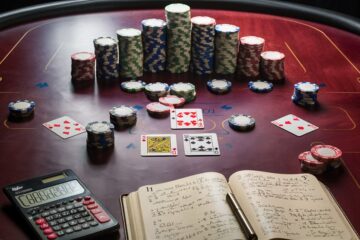Poker Psychology: Turn the Rival’s Attention in Your Favor
Beating a Poker Game Through Emotion Awareness
Professional poker players convert opponent stress into actionable information. Mastering emotional intelligence and maintaining strategic focus under pressure are critical to success.

Dealing with Emotionally Volatile Opponents
- Mental fortitude is key against aggressive or emotional rivals.
- Top players analyze stakes, betting patterns, and timing fluctuations to exploit psychological weaknesses.
Table Talk & Psychological Indicators
Advanced Psychological Control Techniques
- Breathing exercises for emotional regulation.
- Mental reset protocols to maintain focus.
- Turning pressure into profit through tactical adjustments.
Elite-Level Poker Psychology
- Pattern recognition of opponent behavior.
- Emotion-based tactical adjustments.
- 놀라운 수익 치명적인 팟
- Controlled aggression at key moments.
Frequently Asked Questions
Q: How do you stay calm against aggressive players?
A: Systematic analysis and emotional regulation—viewing aggression as valuable intelligence.
Q: What are the signs of an opponent on tilt?
A: Unusual betting patterns, increased aggression, timing shifts, and physical stress indicators.
Q: How can I avoid emotional decisions?
A: Use structured decision-making and pre-planned breathing techniques.
Q: How do I handle table talk?
A: Maintain professional detachment and focus on strategic play.
Q: How do you exploit an opponent’s tilt?
A: Adjust bet sizing to capitalize on predictable emotional reactions.
Poker as Psychological Warfare: Gaining a Strategic Edge
Training for Mental Control
- Professional players train to remain emotionally neutral.
- Understanding opponent pressure points leads to strategic exploitation.
Exploiting Psychological Principles
- Recognizing timing-based pressure and non-verbal cues.
- Adapting to opponent betting patterns and 토토사이트 table dynamics.
Mathematical Approaches to Mental Dominance
- Opponents performing at less than optimal potential increase expected value (EV).
- Exploiting their cognitive weaknesses directly impacts long-term profitability.
Frequently Asked Questions
Q: Why is emotional control critical in poker?
A: It ensures logical decision-making, preventing costly mistakes due to emotional impulses.
Q: How do players build mental toughness?
A: Daily mindfulness, tracking psychological patterns, and viewing the game through a mathematical lens.
Q: What makes psychological strategy important in professional poker?
A: It allows players to exploit opponents’ cognitive weaknesses.
Q: What separates elite players from the rest?
A: Superior emotional management, patience, and the ability to thrive under pressure.
The Mental Game Under Pressure
Handling High-Stakes Poker Moments
Success in poker hinges on psychological resilience in high-pressure situations.
Three-Step Pressure Management System
- Physical Control & Breathing
- Intentional breathing techniques create a buffer between stimulus and response.
- Prevents rushed decisions in crucial hands.
- Strategic Focus
- Break down pressure situations into mathematical problems.
- View chips as strategic units, not emotional triggers.
- Opponent Psychology Evaluation
- Identify tilt indicators and desperation moves.
- Capitalize on psychological vulnerabilities.
Frequently Asked Questions
Q: How do you stay calm in big hands?
A: Breathe systematically, control physical responses, and approach decisions strategically.
Q: What are key tilt indicators?
A: Hasty decisions, increased aggression, and visible frustration.
Q: How do you stop making emotional decisions?
A: Develop strict decision-making protocols and track betting patterns.
Q: How do you handle aggressive opponents?
A: Stay emotionally detached and adjust bet sizing strategically.
Q: Why is mental preparation crucial in poker?
A: Psychological control is essential for consistency, especially in high-stakes situations.
Reading Emotional Tells
Baseline Behavior Analysis in Live Poker
Professional players use emotional tells to gain insight into an opponent’s hand strength and decision-making process.
Key Physical Tells
- Eye tension when bluffing.
- Throat-clearing as a subconscious tell.
- Breathing changes in high-pressure situations.
Advanced Techniques to Counter Tells
- Establish a player’s natural baseline before identifying deviations.
- Recognize displacement activities (chip manipulation, time-checking, self-soothing gestures).
Pattern Recognition vs. Single Tell Analysis
- Reliable reads come from behavioral clusters rather than isolated actions.
Frequently Asked Questions
Q: What are the most reliable poker tells?
A: Clusters of synchronized behaviors deviating from a player’s natural baseline.
Q: How can I prevent opponents from reading me?
A: Maintain emotional neutrality and consistent physical actions.
Q: Are online poker tells as effective as live tells?
A: Online tells rely on timing and betting patterns rather than physical behaviors.
Q: How long does it take to learn how to read tells?
A: Months of practice and observation.
Q: Are all tells reliable?
A: No, experienced players can fake tells to mislead opponents.
Breaking the Tilt Cycle
What is Poker Tilt & How to Stop It
Tilt is one of the most common psychological pitfalls in poker, leading to progressively poor decisions and mounting losses.
Three-Step Tilt Intervention System
- Immediate Disruption
- Take a break, breathe deeply, and step away for at least two minutes.
- Self-Assessment
- Monitor heart rate, muscle tension, and thought clarity.
- Objective Review
- Determine if you can return to play at peak performance.
Preventative Tilt Techniques
- Set tilt triggers and corrective actions.
- Establish loss limits and session time boundaries.
- Use tracking software for objective gameplay analysis.
Frequently Asked Questions
Q: What are early signs of tilt?
A: Heart rate increase, aggressive betting, and frustration after losses.
Q: How long should I take a break when tilting?
A: At least 15-20 minutes or until emotional stability returns.
Q: Can tracking software help prevent tilt?
A: Yes, it highlights deviations from optimal strategy.
Q: What should I record in a tilt diary?
A: Triggers, emotional state, monetary impact, and corrective actions.
Q: What is the best way to set loss limits?
A: Define strict stop-loss rules to maintain bankroll discipline.
Channeling Tilt into Profits
Understanding Gaming Tilt & Technical Tilt
Strategic tilt control requires accepting frustration rather than suppressing it. Skilled players use tilt energy to sharpen focus and enhance strategic execution.
Transforming Emotional Signals into Strategic Advantages
- Recognizing tilt triggers before they spiral out of control.
- Using emotional energy to remain competitive.
- Establishing strict decision-making protocols.
High-Pressure Poker Protocols
- Identify emotional triggers.
- Redirect negative energy into structured play.
- Implement discipline in decision-making under stress.
Frequently Asked Questions
Q: How do I prevent tilt from ruining my play?
A: Follow structured emotional management protocols.
Q: What is the best strategy for tilt management?
A: Recognize triggers, mentally reframe them, and focus on fundamentals.
Q: How long does it take to master emotional control?
A: It requires practice, self-awareness, and tracking progress over time.
Q: Can emotional responses enhance gameplay?
A: When properly controlled, emotions can improve focus and decision-making.
Q: How do elite players manage emotions differently?
A: They maintain control over reactions, staying disciplined and unaffected by variance.
By mastering poker psychology, reading emotional tells, and managing tilt effectively, players can turn psychological weaknesses into strategic strengths and maximize long-term profitability.
O


